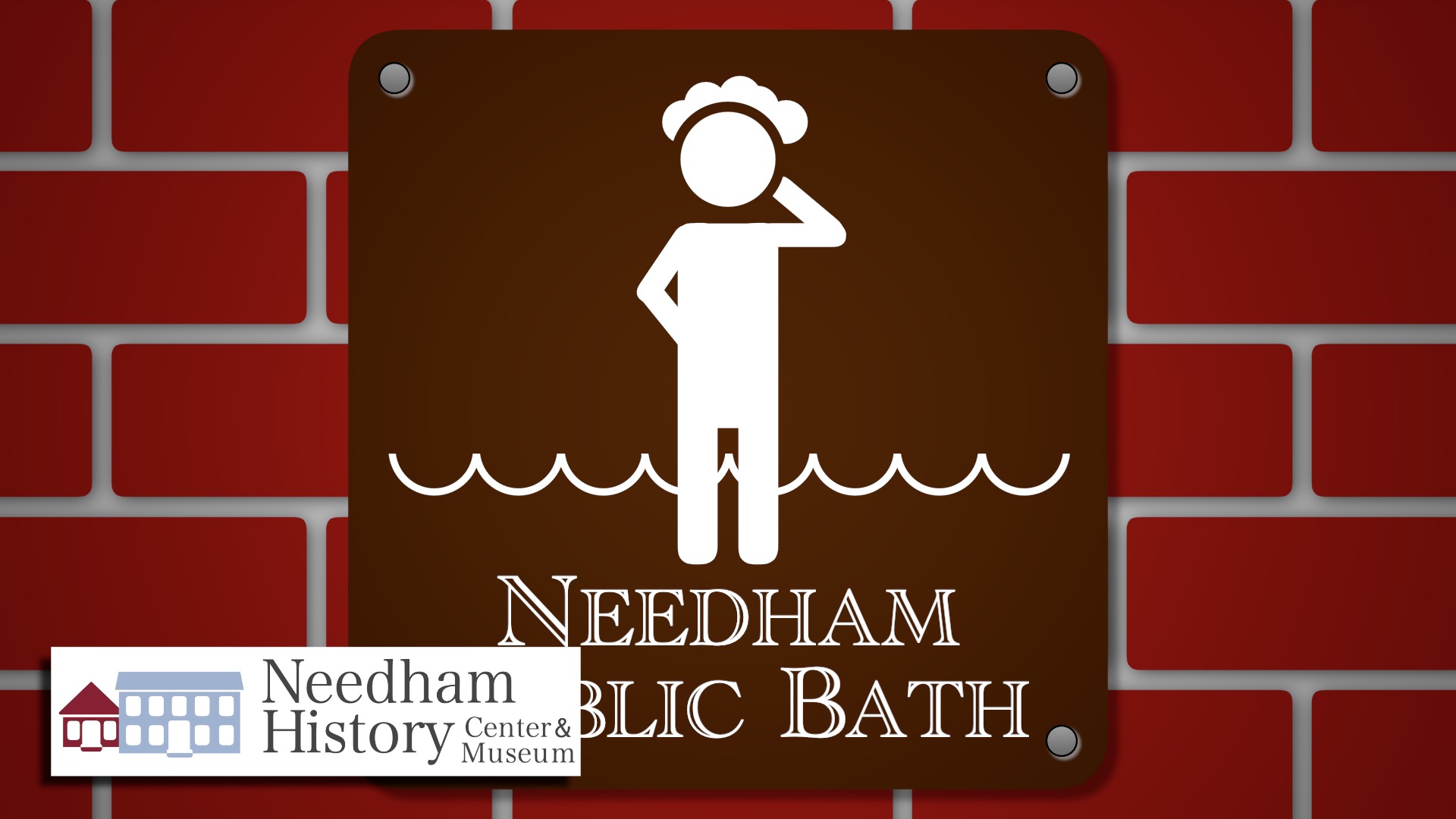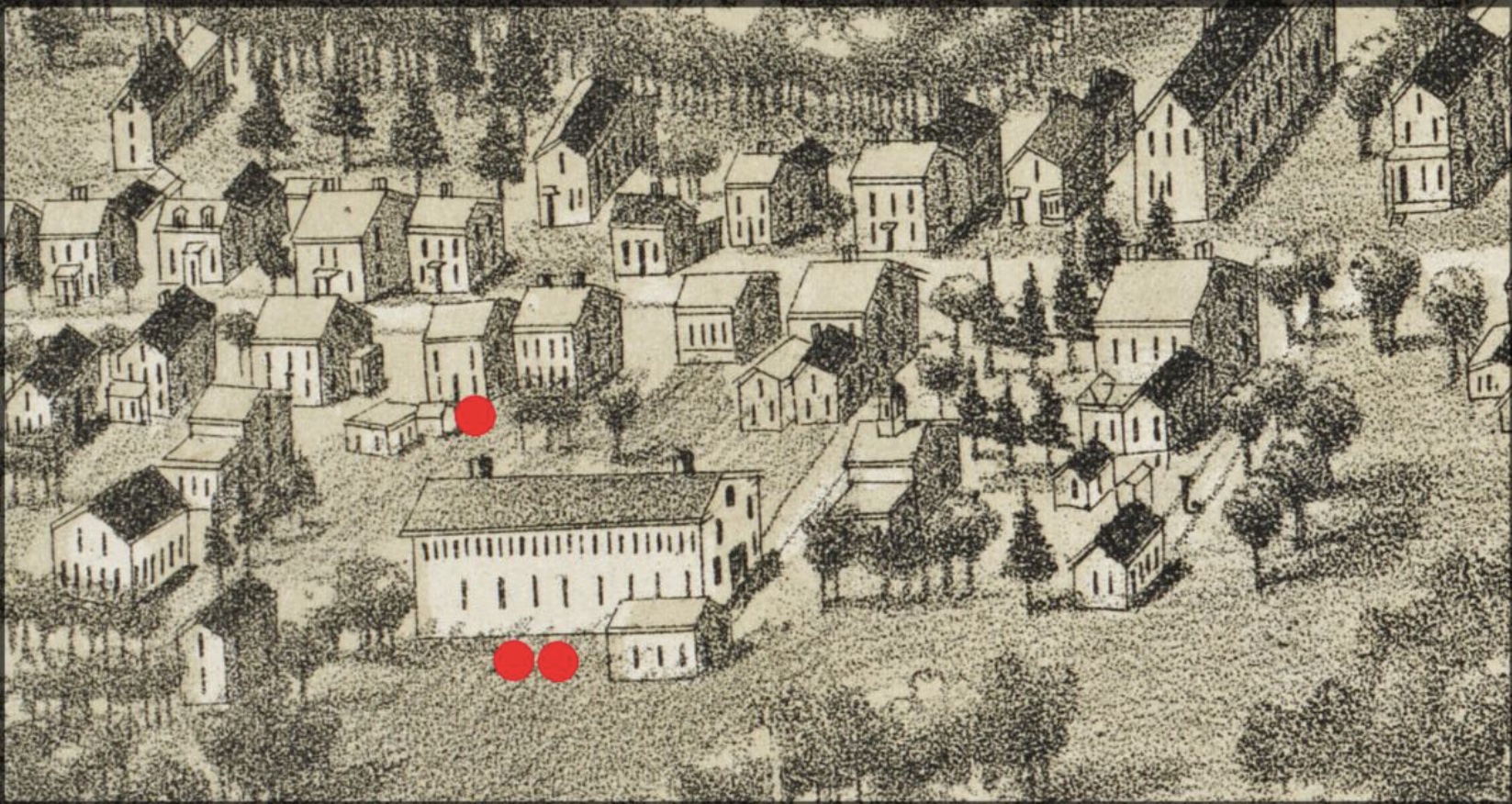
Needham History: Herbert Hudson’s Bathhouse
Needham had a public bathhouse – who knew?

Hunnewell Street between Hillside Avenue and Bobsled Drive (a detail from the 1887 birds-eye map). Lyne’s knitting mill is at the double dots. Herbert Hudson’s house with its two small outbuildings, is at the single dot.
Herbert Hudson’s Bathhouse
The May 11, 1901 issue of the Needham Chronicle contained the following mysterious notice:
“The new public bathhouse of Herbert Hudson, on Hunnewell Street, is nearing completion. It is 30 x 22 [feet], two stories high, with an ell 30 x 18. On the first floor are the manager’s office, waiting room, lockers and lavatory. From here, access is gained to the ell, in which is a vapor bath and swimming tank. The tank is 30 x 18, 4 feet 6 inches deep at the entrance, sloping to 6 feet, heated by steam. One-half of the upper floor is reserved for the individual bathrooms, and the other half will probably be fitted up as a gymnasium, though not yet decided. This is the first public bathhouse in the town of Needham, and during its erection much speculation has been indulged in as to what it was to be used for, and it is only this week that the owner has taken the public into his confidence.”
Public bathhouses date back to ancient times. They were not only for personal hygiene, but provided access to fitness equipment, swimming, and a casual social setting. It was certainly possible to bathe in a river, or carry the water from the well to be heated in a kitchen tub, and this is what people did most of the time. But what luxury to bathe in heated water that you did not have to carry in (and out again), relax in the steam room, or take a swim! The descendants of these bathhouses are the modern multi-functional athletic facilities like the YMCA.
Until the mid-19th century, most people just (occasionally) washed their faces, hands, and feet. By the 1840s, “hydrotherapy” (full-immersion bathing to treat health conditions) became all the rage, and hot springs became popular resort sites for the wealthy. In the later 19th century, bathing for recreation as well as for health became popular, and with it the establishment of inexpensive year-round bathhouses for working people, that usually included athletic facilities as well as bathing facilities. These were also seen as a boost to public health, especially in the cities.
We take indoor plumbing for granted, but it has only been common for around a century. American building codes that required indoor plumbing in new construction generally date to the 1920s, and there was not mandate to retrofit older houses. Public bathhouses eventually declined as plumbing became more common. However, it is unlikely that most of the houses in Needham in 1901 could boast of running water. So, Herbert Hudson was a welcome local part of this bathhouse trend, providing Needham with a facility for both hygiene and recreation.
Unfortunately, that short newspaper clip is most of what we know about Hudson’s bathhouse. We don’t even know very much about Herbert Hudson. We know a little bit about Herbert Hudson’s father Samuel, who was a prominent man in Needham Heights. Samuel Hudson came to Needham from England in the 1860s, and owned a small knitting business on Hunnewell Street. In the 1883 Directory he is listed as a “framework knitter” (ie, a guy who owned his own loom and worked independently); by 1888 he is a “woolen goods manufacturer,” implying that the business had grown. His ad proclaimed that he was a manufacturer of “Shetland Shawls, Polka Mittens, Gloves, and Hosiery.” He also owned other parcels of land in Needham, and was a trustee of the first Public Library.
About his son, the bathhouse owner Herbert, we unfortunately know very little. The 1876 Comstock and Cline map shows that Herbert Hudson owned a house at 67 Hunnewell Street (Hunnewell Street was renumbered in the 1930s, but #67 would have been roughly between what is now Bobsled Drive and Andrea Circle). In 1876 the property held a single structure. In the 1893 and 1896 Needham Directories, Hudson is listed as a knitter working at Alexander Lyne’s mill on Hunnewell Street (now the long building that is part of Brookline Rug). Lyne’s mill was only one house over from Hudson’s house, so the commute was easy.
But this was before Hudson branched out into bathhouses. According to the 1901 Town Report, the property at 67 Hunnewell included not only the house, but a stable, a bathhouse, and 3 acres of land. The bathhouse appears in the Assessor’s List from 1901 until 1907. After 1907, Hudson is assessed for the house, stable, and 3 acres of land, but the bathhouse is gone. The 1909 Bromley Atlas bears this out – there is a house and small outbuilding (the stable) belonging to Herbert Hudson, but no other buildings on the property.
Try as we might, we could not find anything in the Chronicle that mentioned the closing or demolition of Hudson’s bathhouse. So this is where our story ends. I wish it could be longer, but we have run out of information, and even out of food for speculation.
Many thanks to our Archivist, Polly Attridge, who pointed out the Chronicle’s article to me in the first place, and then spent a great deal of time trying in vain to find more information.
 |
Gloria Polizzotti Greis is the Executive Director of the Needham History Center & Museum. For more information, please see their website at www.needhamhistory.org. |

